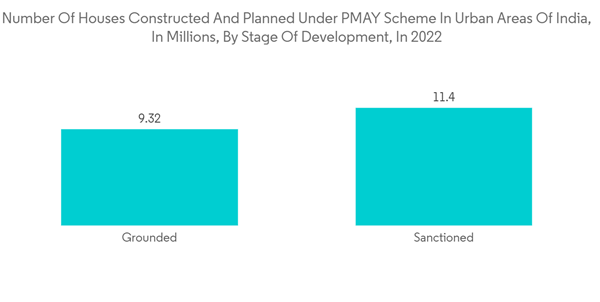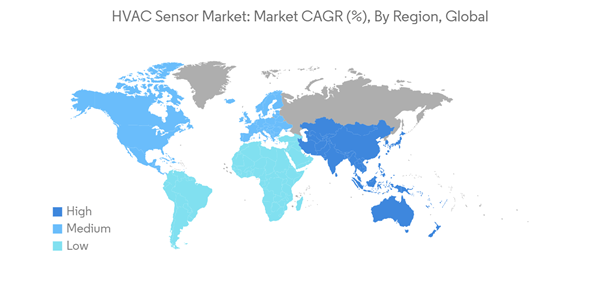The HVAC sensors regulate and monitor various activities like air temperature, pressure, and quality in end-user buildings like commercial and residential buildings. Hence, HVAC sensors are being commonly used owing to the increasing need to reduce energy consumption and enhance energy efficiency.
Key Highlights
- The rapid rise in industrialization and urbanization worldwide is one of the primary factors driving the market's growth. The significant increase in the construction of different commercial and residential buildings worldwide is creating considerable demand for HVAC sensors as a space heating and cooling system, ventilation control, humidity control, and air filtration. For instance, according to the IEA, the global building construction sector's value increased by 5% compared to the previous year, reaching over USD 6.3 trillion.
- Increasing sensor compatibility with the Internet of Things (IoT) platform is gradually becoming a prerequisite for facilitating remote monitoring and control. IoT-connected devices have opened massive opportunities for sensors in several applications like industrial, medical, consumer electronics, automotive, etc. According to Cisco's Annual Internet Report, by 2023, there is expected to be nearly 30 billion network-connected device connections, up from 18.4 billion in 2018. By 2023, IoT devices were expected to make up 50% (14.7 billion) of all networked devices, up from 33% (6.1 billion) in 2018. Such an increase in IoT devices would drive the growth of the studied market.
- Heating, ventilating, and air-conditioning in a commercial building usually consume more energy than any other activity in the building. According to U.S. Department of Energy studies of commercial buildings, HVAC equipment usually accounts for over 40% of a building's energy usage. Owing to the huge amount of energy, HVAC systems use sensors to improve equipment efficiency, which results in significant reductions in building operating costs.
- For instance, HVAC monitoring systems include IoT sensors for monitoring temperature, occupancy, fresh air intake, and other indoor climate conditions. Controllers and actuators turn the data collected from these sensors into action. Some actions are immediate and preprogrammed into the system. Smart building management platforms with machine learning capabilities that provide in-depth insights and continuously refine adjustments carry out more complex analyses.
- Furthermore, energy standards and building codes have also significantly driven the design of energy efficient buildings over the past decade. For instance, the US Green Building Council's (USGBC) leadership in the Energy and Environmental Design (LEED) Green Building Rating System has raised awareness of the need for building designs that use energy efficiently. As such, several states in the country have mandated the use of the LEED rating system for government buildings.
- Such initiatives indicate the importance of energy conservation in buildings. Hence, HVAC sensors are being commonly used because the need to reduce energy consumption is increasing, enhancing energy efficiency. As a result, the government and regulatory organizations are primarily focusing on how HVAC controls can reduce energy consumption in buildings.
- The pandemic significantly influenced the HVAC industry, as demand for the sensors observed a significant drop during the initial months, owing to lockdown restrictions and businesses refraining from investing in new equipment. Due to the pandemic, many construction projects were halted across the world. The reduction in construction activities across the commercial, residential, and industrial sectors temporarily dampened the demand for HVAC sensors, including those for air handling units.
- Moreover, due to the production shutdown in countries such as China, multiple industries observed a shortage of supply of various products during February and March 2020. Due to supply chain disruption, the price of raw materials increased, impacting the overall pricing of the sensors.
HVAC Sensor Market Trends
Increased Construction and Retrofit Activity to Aid the Market's Growth
- According to JRAIA, the global demand for room air conditioners has increased to 95.16 million in recent years. Furthermore, according to the United Nations, the world's population was projected to reach 8 billion on November 15, 2022. The latest projections by the organization suggested that the global population could reach around 8.5 billion in 2030, 9.7 billion in 2050, and 10.4 billion in 2100. Declining levels of mortality partly influence population growth.
- Furthermore, in emerging markets like the Asia Pacific region, especially China and India, many people have been migrating from rural areas to cities, raising government and private spending on housing, commercial construction, and infrastructure. New building construction is creating significant demand for new equipment installations for heating, ventilation, and air conditioning systems. Hence, the growing construction industry would likely drive the studied market.
- For instance, in November 2021, the Indian government approved the construction of 3.61 lakh houses under the Pradhan Mantri Awas Yojana (Urban). The approval of the new housing units takes the total number of sanctioned houses under the scheme to 1.14 crore. Such trends positively contribute to the demand for HVAC sensors, in newly installed HVAC systems.
- Moreover, increasing building renovation projects by the government to make them more energy-efficient are significantly increasing the global HVAC sensor market. This is because energy-efficient buildings can help reduce greenhouse gas emissions, lower energy bills for homeowners and businesses, and improve indoor air quality, thus making them suitable for public health.
- Moreover, a country like Europe has presented the European Green Deal, an ambitious package of policy measures to make Europe the first climate-neutral continent by 2050. The European Green Deal aims to double or even triple building renovation rates and speed up building digitization to ensure the EU's building stock is on track to decarbonize by 2050.
- Therefore, with the growing construction and retrofit activities, there will be a significant rise in the demand for energy-efficient HVAC sensors for maintaining comfortable indoor temperatures and good air quality in buildings, owing to the need to reduce energy consumed, increasing and leading to the enhancement of energy and its efficiency.
Asia-Pacific Expected to Register Fastest Growth
- The Asia-Pacific HVAC sensor market is predicted to rise steadily due to commercial and residential construction activity in India and China and rising consumer expenditure on luxury products. Low ownership rates and increased disposable income in Asia will likely boost the market's growth. Due to rising demand from India and China, the residential sector accounted for a significant portion of the Asia-Pacific HVAC sensor market.
- According to the China Construction Industry Association, in 2021, residential structures accounted for the largest share of finished construction in China. Buildings intended for housing accounted for over 67 percent of the completed floor space. As the country's economy grows, people migrate from rural areas to major cities, increasing demand for residential accommodation in these locations. Furthermore, apartments utilized as investment properties drive up demand. Such huge residential construction is expected to drive the studied market.
- Besides, the increase in commercial buildings is estimated to affect national energy consumption directly, so the Chinese government has seriously considered energy management. Two laws, the Energy Saving Law and the Renewable Energy Law, provide the main guidelines for building energy systems and the HVAC and R industries.
- The players in the region are developing new products to capture market share. For instance, in March 2022, Voltas unveiled India's first AC with HEPA filter technology. Voltas' PureAir 6 Stage Adjustable Inverter AC is embedded with a PM 1.0 air quality sensor and AQI indicator (an industry first) that helps to purify the indoor air and is also loaded with 6 Stage Adjustable Tonnage Mode, which allows the user to switch between multiple tonnages depending on the ambient heat or number of people in the room. It provides pure and clean air, cost savings, and energy optimization.
- Further, according to RAP (Regulatory Assistance Project), heat pump installations in the country reduced CO2 emissions by 81 million metric tons in 2021. RAP calculated that with every 1% increase in heat pump uptake in China's buildings, an additional 7.1 Mt of CO2 may be avoided each year. Presently, just 3.4% of building area in China uses heat pumps for space heating, indicating a considerable possibility to grow deployment and reduce CO2 emissions countrywide.
- Such estimates encourage the adoption of efficient HVAC sensors in the region. Since IoT HVAC monitoring systems help buildings heat and cool spaces more efficiently, Sensor data can be used to evaluate equipment performance, identify inefficiencies, and create efficiency-focused automation strategies based on a range of variables.
- IoT devices can also monitor elements within an HVAC system, including variable air volume systems and fan coils, to promote energy efficiency. For instance, motion-activated air conditioning systems use sensors that turn themselves off and on based on movement in the home, saving money in the absence of anyone in the home.
HVAC Sensor Industry Overview
The increasing presence of prominent manufacturers in the HVAC sensors market is expected to intensify competitive rivalry during the forecast period. Market incumbents like Siemens AG, Emerson Electric Co., Honeywell International Inc., and TE Connectivity Ltd. considerably influence the overall market. Players in the market are adopting strategies such as partnerships and acquisitions to enhance their product offerings and gain a sustainable competitive advantage.In March 2023, Sensirion announced the release of the SHT40I-Analog humidity sensor, which is intended for demanding industrial applications and severe settings where high noise levels may make digital solutions ineffective. The novel sensor allows for simple design and customer-specific output characteristics for high-volume applications.
In April 2022, Trane Technologies PLC announced a strategic continuing collaboration to achieve higher energy efficiency using Air-Fi wireless sensors for Trane and Mitsubishi Electric City multi VRF and improvements to the IntelliPak 1 HVAC Rooftop Unit. The upgrades give building owners technology, data, and controls to help them satisfy efficiency standards, achieve decarbonization targets, and make retrofits easier and more cost-effective.
Additional Benefits:
- The market estimate (ME) sheet in Excel format
- 3 months of analyst support
This product will be delivered within 2 business days.










